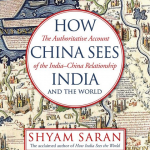Ambassador Shyam Saran in his recent book How China Sees India and the World demystifies China’s imagined belief of itself as the Middle Kingdom – at the centre of the whole world- enjoying extended pre-eminence amongst the comity of nations. The Chinese narrative of continuous unbroken history of its civilization with eternal geography, the author asserts, is an exercise in Sinicization of all aspects of the Chinese identity, including local languages, religious beliefs, customs, traditions and ways of living, under one single command structure.
Saran knows of whereof he speaks. He is one of India’s leading Sinologists, a fluent Mandarin speaker who has served in China in his early career and managed the bilateral in several positions including as India’s foreign secretary.
His book has dwelt at length with the extensive interactions between India and China from the early first millennium, an engagement derived from both cultural and religious faiths as well as vibrant trade exchanges with the Malabar kingdoms up to the 13th Century. From the laudatory accounts of the Chinese Buddhist scholar Xaun Zang in the 7th Century AD, the reader gets a sense of the Chinese perception of India as a centre of advanced civilization and repository of knowledge, impacting virtually all aspects of Chinese culture. China’s cultural debt to India has not been acknowledged yet, but this may be to avoid risking validation of its pervasive notion of itself as the node of civilizational excellence.
China’s propensity to cut and paste history, mainly to serve its political objectives, keeps cropping up time and again in China’s relations with the contemporary external world, and is well illustrated in the book. As a case in point, Tibet, until its forceful occupation in 1950, was never under direct Chinese rule; it was always a part of the Mongol Yuan dynasty, just as the vast plateau of Aksai Chin was never under the Qing Empire even at its maximum extent. In both these situations, as in India’s Northeast, the Chinese use false historical narratives for territorial claims and unleash rhetoric to legitimise them. It has become a trademark China tactic with most of its neighbouring countries.
The moment of reckoning for China, which exposed its vulnerability, was the Opium war years of the 19thcentury when it was decimated by Western forces and major concessions extracted under unequal treaties –the Treaty of Nanjing and Treaty of Tianjin. The century of humiliation ended with the liberation of China on 1stOctober 1949 through the victory of the communist forces led by Mao Zedong, who reinforced his long-held belief in a strong central authority capable of repulsing such attacks. Economic objectives are never allowed to undermine the political dominance of the Communist Party of China.
Saran thinks that China’s negative perception about India is largely coloured by its prejudices and limited understanding of India’s history and freedom struggle. It resented Indian soldiers being used as pawns by the British Empire during the Opium wars. Post 1947, the continuation of Lord Mountbatten as Governor General and functioning of much of Indian administration and armed forces under British rules, were often highlighted to cast doubts on India’s true independence. In the Chinese perception, lack of a strong central political authority to mobilize its people to resist alien invaders will render India weak and enslave the country.
Currently, China is assessing India through the prism of its deteriorating relations with the U.S., believing that it could potentially use India as a platform to launch an assault on China. Hence, the need to neutralize India. China believes that U.S. is a great power in retreat and the inevitability of Chinese dominance of the world as futile to resist. Analysing these deeper strands in the Chinese perception of India and the prism through which it interprets Indian foreign policy, the author says, is critical.
The book provides a valuable overview of the economic growth patterns of both India and China whose GDP were similar in 1978 at around $ 293 billion, but today China has overtaken India’s GDP by five times. China’s phenomenal economic success was attained under Chinese leader Deng Xiaoping by pursuing an export and investment-led growth strategy like those of East and Southeast Asian countries. Deng’s wise counsel of ‘crossing the river by feeling the stones’ allowed China to absorb advanced technologies of the West to steadily build up its own capabilities in a wide range of cutting-edge technologies, including artificial intelligence, quantum computing, 5G and robotics. The author cautions that India must be wary of the economic chasm which makes China less sensitive to India’s interests and exhibits a lower threshold of tolerance towards India.
Saran counsels against India seeking to become another China, whose rapid economic growth and prosperity owes much to its embrace of globalization and less to its one-party authoritarian system. But an aspirational India should move on a similar economic trajectory of developing an ecosystem with advanced knowledge and technology that enables swift assimilation and innovation. Most developed countries have followed this logic, which India must painstakingly pursue. Like Japan, the West too, recognizes that India is the only country which has the civilizational depth, population, significant managerial, technical and entrepreneurial skills to match China – and more, sustainably and over the long term.
Saran, Shyam, How China Sees India and the World. Juggernaut publications (India), 2022.
Dammu Ravi is Secretary ( Economic Relations), Ministry of External Affairs.
This book review was exclusively written for Gateway House: Indian Council on Global Relations. You can read more exclusive content here.
For permission to republish, please contact outreach@gatewayhouse.in
©Copyright 2022 Gateway House: Indian Council on Global Relations. All rights reserved. Any unauthorised copying or reproduction is strictly prohibited.


